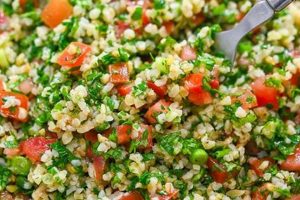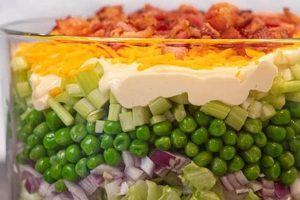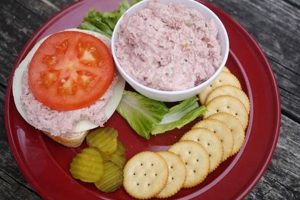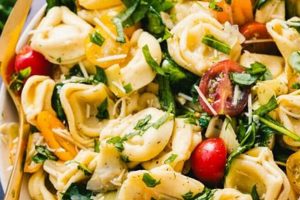A plant-based rendition of the classic American salad, this dish typically replaces traditional ingredients like chicken, bacon, and blue cheese with vegan alternatives. For example, crumbled tofu or tempeh often stands in for chicken, while coconut bacon or shiitake mushrooms provide a smoky, savory element. A cashew-based dressing can replicate the creamy texture of blue cheese dressing. Avocado is a common addition, contributing healthy fats and a rich flavor.
This variation offers a lighter, cholesterol-free alternative to the traditional cobb, while still delivering a satisfying and flavorful meal. It caters to dietary restrictions and ethical choices, expanding the accessibility of this classic dish. The adaptability of plant-based ingredients allows for creative interpretations and personalized flavor profiles, promoting culinary exploration within a healthier framework. Further, it aligns with growing consumer interest in sustainable and compassionate food choices.
The following sections will explore specific ingredient choices, preparation techniques, and variations for crafting a delicious and visually appealing plant-based cobb salad. Nutritional information and tips for optimal flavor combinations will also be discussed.
Tips for Crafting the Perfect Vegan Cobb Salad
Achieving a well-balanced and flavorful vegan cobb salad involves careful consideration of ingredient selection and preparation techniques. The following tips offer guidance for optimizing both flavor and texture.
Tip 1: Texture Variety is Key: Incorporate a range of textures for a more engaging culinary experience. Crisp romaine lettuce can be complemented by creamy avocado, crunchy roasted chickpeas, and chewy marinated mushrooms.
Tip 2: Maximize Flavor with Marinated Tofu: Pressing and marinating tofu prior to cooking enhances its flavor absorption and creates a more satisfying protein element. Consider a smoky or savory marinade to replicate traditional bacon flavors.
Tip 3: Explore Creative “Bacon” Alternatives: Beyond tofu, explore other bacon substitutes such as smoked tempeh, coconut bacon, or roasted shiitake mushroom caps. Each option offers a unique texture and flavor profile.
Tip 4: Don’t Neglect the Dressing: A well-crafted dressing is crucial. Cashew-based dressings provide a creamy texture reminiscent of traditional blue cheese dressings, while tahini or avocado-based options offer a lighter, brighter alternative.
Tip 5: Balance Flavors: Strive for a balance of salty, sweet, tangy, and savory elements. Roasted vegetables, such as sweet potatoes or bell peppers, can introduce sweetness, while a sprinkle of nutritional yeast adds a savory, cheesy note.
Tip 6: Presentation Matters: Arrange the ingredients thoughtfully for an aesthetically pleasing presentation. Consider arranging the components in rows or sections to showcase the vibrant colors and textures.
By following these tips, one can create a vegan cobb salad that is not only nutritious and delicious but also visually appealing. Careful attention to detail elevates this simple dish to a truly satisfying culinary experience.
The following section will offer several variations on the classic vegan cobb, incorporating seasonal ingredients and global flavor influences.
1. Plant-based protein
Plant-based protein sources are fundamental to a successful vegan cobb salad, providing essential nutrients and contributing to a satisfying texture and flavor profile. They replace traditional animal-based proteins like chicken or bacon, offering a healthier and more ethical alternative.
- Tofu:
A versatile soy-based protein, tofu readily absorbs marinades, making it ideal for replicating smoky or savory flavors. Crumbled or cubed, it provides a substantial texture similar to chicken or feta cheese. Properly prepared tofu contributes significantly to the overall satisfaction and nutritional value of the salad.
- Tempeh:
Tempeh, another fermented soy product, offers a firmer texture and nuttier flavor than tofu. It can be crumbled, sliced, or diced, providing a hearty and flavorful addition to the salad. Its distinct flavor profile complements other ingredients well, adding depth and complexity.
- Legumes:
Chickpeas, lentils, and black beans offer a variety of textures and flavors. Roasted chickpeas provide a satisfying crunch, while lentils or black beans contribute a more earthy flavor and substantial protein content. Their versatility allows for various culinary applications within the salad context.
- Nuts and Seeds:
While not solely protein sources, nuts and seeds contribute healthy fats, protein, and textural variety. Chopped walnuts, toasted sunflower seeds, or pumpkin seeds can add a pleasant crunch and enhance the nutritional profile of the salad. They also complement the flavors of other ingredients, such as roasted vegetables and leafy greens.
The choice of plant-based protein significantly impacts the overall flavor, texture, and nutritional value of the vegan cobb salad. Selecting a variety of protein sources can create a more complex and satisfying culinary experience while ensuring a complete and balanced meal.
2. Fresh, vibrant vegetables
Fresh, vibrant vegetables are essential to a successful vegan cobb salad, providing crucial nutrients, textural contrast, and visual appeal. Their selection and preparation significantly influence the overall flavor, nutritional value, and aesthetic presentation of the dish. The inherent variety within the plant kingdom allows for diverse combinations, ensuring a balanced and exciting culinary experience. For example, crisp romaine lettuce offers a refreshing base, while juicy tomatoes provide bursts of sweetness and acidity. These contrasting textures and flavors create a dynamic interplay that elevates the salad beyond a simple collection of ingredients.
Beyond the classic combination of lettuce and tomatoes, incorporating a wider range of vegetables enhances both the nutritional profile and the sensory experience. Consider adding crunchy cucumber, bell peppers for sweetness and color, or thinly sliced red onion for a subtle bite. These additions not only contribute vitamins and minerals but also create a visually appealing presentation, stimulating the appetite and enhancing enjoyment. Furthermore, the selection of vegetables can be tailored to seasonal availability, maximizing freshness and flavor while minimizing environmental impact. Locally sourced, in-season produce often exhibits more vibrant flavors and superior nutritional content compared to out-of-season alternatives.
Careful preparation techniques further enhance the qualities of fresh vegetables in a vegan cobb salad. Proper washing and drying ensure optimal texture and prevent wilting. Chopping vegetables into bite-sized pieces promotes even distribution throughout the salad and enhances the overall eating experience. Certain vegetables, such as bell peppers or corn, may benefit from grilling or roasting, which intensifies their sweetness and adds a smoky depth of flavor. Ultimately, the careful selection and preparation of fresh, vibrant vegetables are critical factors in crafting a vegan cobb salad that is both nutritious and aesthetically pleasing.
3. Creamy vegan dressing
Creamy vegan dressings play a pivotal role in vegan cobb salads, contributing richness, flavor, and a textural element that binds the diverse components. The absence of traditional dairy-based dressings necessitates alternatives that replicate the desired creaminess without compromising flavor or ethical considerations. A well-executed vegan dressing elevates the salad from a simple assembly of ingredients to a cohesive and satisfying culinary experience. For example, a cashew-based dressing, made by blending soaked cashews with water, lemon juice, and nutritional yeast, provides a remarkably similar texture and tangy flavor profile to traditional buttermilk or blue cheese dressings. This emulates the classic cobb salad experience while adhering to vegan principles.
The choice of dressing significantly impacts the overall flavor profile of the salad. While cashew cream offers a neutral base that can be flavored in various ways, other options, such as avocado-based dressings, introduce a distinct flavor and a vibrant green hue. Tahini dressings offer a nutty, slightly bitter counterpoint, complementing the flavors of roasted vegetables and smoky tofu. The selection of dressing should consider the other ingredients in the salad, aiming for a balanced and harmonious flavor composition. A dressing that is too overpowering can mask the subtle flavors of fresh vegetables, while a bland dressing fails to enhance the overall experience. Understanding the interplay of flavors between the dressing and other components is crucial for creating a successful vegan cobb salad.
Beyond flavor, the creamy texture of the dressing contributes to the overall satisfaction and enjoyment of the salad. It coats the ingredients, ensuring that each bite delivers a balanced combination of flavors and textures. The creaminess also adds a perceived richness, further enhancing the sensory experience. The absence of this element can result in a salad that feels dry and disjointed. Therefore, achieving the right consistency in a vegan dressing is essential for replicating the indulgent experience of a traditional cobb salad. This understanding of the dressing’s role highlights its significance in the overall composition and success of a vegan cobb salad recipe.
4. Balanced Flavor Profile
A balanced flavor profile is crucial for a successful vegan cobb salad recipe. It distinguishes a simple combination of ingredients from a well-composed dish that offers a complex and satisfying culinary experience. Achieving this balance involves a careful understanding of the interplay between different taste elements salty, sweet, sour, bitter, and umami and how they interact within the context of a salad.
- Salty Elements:
Salt provides a foundational flavor dimension, enhancing the perception of other tastes and creating a savory backbone. In a vegan cobb salad, saltiness can be introduced through ingredients like olives, capers, or a sprinkle of sea salt. It’s essential to control the level of saltiness to avoid overpowering other flavors, allowing the nuances of each ingredient to shine through.
- Sweet Notes:
Sweetness offers a counterpoint to salty and savory elements, adding depth and complexity. Roasted sweet potatoes, ripe tomatoes, or a touch of maple syrup in the dressing can introduce subtle sweetness. This balances the overall flavor profile and prevents the salad from becoming overly savory or one-dimensional. The sweetness also complements the tanginess often found in vegan dressings.
- Tangy and Acidic Components:
Acidity, often derived from vinegar or citrus juice in the dressing, provides brightness and a refreshing contrast to richer elements. It cuts through the fattiness of avocado or the nuttiness of a cashew-based dressing, creating a more balanced and palatable experience. The level of acidity should be carefully calibrated to complement, not overpower, the other flavors.
- Umami Depth:
Umami, the savory, meaty flavor, can be achieved in a vegan cobb salad through ingredients like nutritional yeast, shiitake mushrooms, or roasted vegetables. It adds a depth and complexity that elevates the overall flavor profile. Umami enhances the satisfaction derived from the salad, contributing to a more complete and fulfilling culinary experience.
Harmonizing these flavor elements within a vegan cobb salad creates a symphony of taste sensations, ensuring a satisfying and memorable culinary experience. The balance prevents any single flavor from dominating, allowing each ingredient to contribute its unique character to the overall composition. This careful orchestration of flavors elevates the vegan cobb salad beyond a simple combination of ingredients, transforming it into a dish that is both nutritious and deeply satisfying.
5. Appealing Presentation
Appealing presentation elevates a vegan cobb salad from a simple meal to a visually engaging culinary experience. Strategic arrangement and consideration of color, texture, and overall composition significantly enhance the perceived value and enjoyment of the dish. Visual appeal stimulates appetite and contributes to a more satisfying dining experience, even before the first bite is taken. Presentation, therefore, plays a critical role in the overall success of a vegan cobb salad recipe.
- Color Palette
Vibrant colors contribute significantly to a visually appealing salad. Incorporating a variety of colorful vegetables, such as deep green spinach, bright red tomatoes, and orange bell peppers, creates a visually stimulating presentation. The contrast between these colors enhances the overall aesthetic and makes the salad more enticing. A monochromatic salad, while potentially nutritious, lacks the visual appeal that encourages consumption and enjoyment.
- Textural Contrast
Varying textures add another dimension to the presentation. Combining crisp lettuce with creamy avocado, crunchy nuts, and chewy tofu creates visual interest and a more engaging sensory experience. This textural diversity not only enhances the visual appeal but also contributes to a more satisfying mouthfeel, further elevating the dining experience. A salad with uniform textures, regardless of flavor, can appear monotonous and less appealing.
- Ingredient Arrangement
Thoughtful arrangement of ingredients enhances the visual appeal and perceived craftsmanship of the salad. Arranging ingredients in distinct rows or sections, rather than simply tossing them together, showcases the variety and allows each component to stand out. This structured approach creates a sense of order and intentionality, elevating the presentation beyond a casual mixture of ingredients.
- Plating and Garnishing
The choice of serving dish and the use of garnishes further contribute to the overall presentation. A simple white plate provides a clean backdrop that allows the vibrant colors of the salad to shine. A sprinkle of fresh herbs, such as parsley or chives, adds a final touch of visual appeal and a burst of fresh aroma. These seemingly minor details elevate the presentation, demonstrating attention to detail and enhancing the overall dining experience.
By considering these aspects of presentation, a vegan cobb salad transforms from a basic meal into a visually stunning and more enjoyable culinary creation. The thoughtful combination of color, texture, arrangement, and plating elevates the dining experience, demonstrating that visual appeal is an integral component of a successful vegan cobb salad recipe.
Frequently Asked Questions
This section addresses common inquiries regarding the preparation and enjoyment of vegan cobb salads, offering practical guidance and clarifying potential uncertainties.
Question 1: What can be used as a substitute for bacon in a vegan cobb salad?
Several options provide a smoky, bacon-like flavor. Coconut bacon, made from seasoned and baked coconut flakes, offers a crispy texture and a subtly sweet and smoky taste. Tempeh bacon, achieved by marinating and pan-frying tempeh, provides a chewier, more savory option. Alternatively, roasted shiitake mushrooms can deliver a rich, umami flavor and meaty texture.
Question 2: How can the creaminess of traditional cobb salad dressings be replicated in a vegan version?
Cashews, when soaked and blended, create a remarkably creamy base for vegan dressings. Blended avocado also provides a smooth, rich texture. These bases can be flavored with nutritional yeast for a cheesy tang, lemon juice for brightness, or herbs and spices for added complexity.
Question 3: Can vegan cobb salad be made ahead of time?
While the components can be prepared in advance, assembling the salad immediately before serving is recommended. This prevents the lettuce from wilting and the other ingredients from becoming soggy, preserving the desired textures and flavors. Store prepared components separately and combine just prior to serving.
Question 4: What are some suitable protein sources for a vegan cobb salad beyond tofu?
Tempeh, chickpeas, lentils, and black beans provide substantial protein content and diverse textures. These options contribute valuable nutrients and offer a variety of flavor profiles to complement the other salad components. Roasted chickpeas, in particular, provide a satisfying crunch.
Question 5: How can a vegan cobb salad be made more visually appealing?
Strategic arrangement of ingredients enhances the visual appeal. Consider arranging the components in distinct rows or sections to showcase the variety of colors and textures. A sprinkle of fresh herbs or a dusting of paprika can also elevate the presentation.
Question 6: Is a vegan cobb salad a nutritionally balanced meal?
A well-composed vegan cobb salad can indeed be a nutritionally balanced meal. It provides a combination of plant-based protein, healthy fats from avocados and nuts, fiber from vegetables, and a variety of vitamins and minerals. Ensuring a diverse range of ingredients contributes to a more complete nutritional profile.
Understanding these key aspects of vegan cobb salad preparation ensures a satisfying and enjoyable culinary experience. By addressing these frequently asked questions, individuals can approach the creation and consumption of this dish with confidence and a deeper understanding of its nuances.
The following section will offer a collection of diverse vegan cobb salad recipes, showcasing the versatility and adaptability of this plant-based culinary creation.
Conclusion
Exploration of the vegan cobb salad recipe demonstrates the adaptability of classic culinary traditions to meet evolving dietary preferences and ethical considerations. Key elements, including plant-based protein selection, diverse vegetable incorporation, creamy vegan dressing formulation, and balanced flavor profiles, contribute to a successful and satisfying outcome. Attention to presentation further elevates this dish, transforming it from a simple meal into a visually appealing culinary experience. Careful consideration of these aspects allows for the creation of a nutritionally balanced and flavorful plant-based alternative to the traditional cobb salad.
The vegan cobb salad represents more than a mere substitution of ingredients; it embodies a shift towards more conscious and compassionate culinary practices. This adaptation not only caters to specific dietary needs but also encourages broader culinary exploration within a plant-based framework. Further development and refinement of vegan culinary techniques promise continued expansion of accessible and delicious plant-based cuisine, offering both flavorful and ethical dining experiences.






